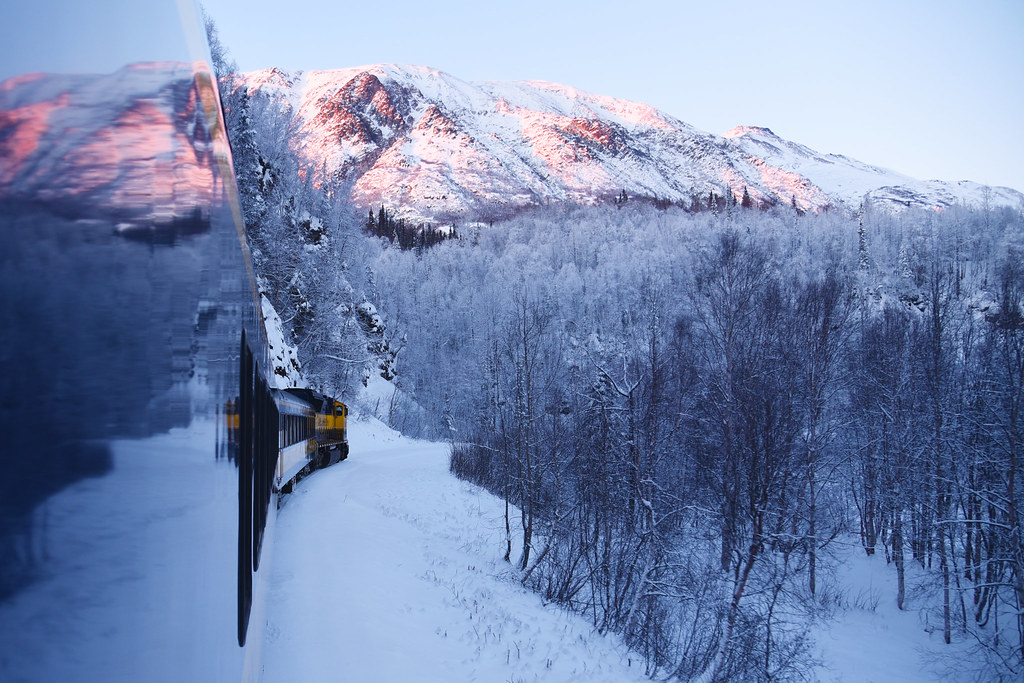
Hurricane Gulch Train Observation Spot, located along the Alaska Railroad (ARR), offers breathtaking views of the surrounding wilderness. Situated near the iconic Hurricane Gulch Bridge, it provides a unique vantage point to witness the dramatic landscapes of Alaska, including deep valleys and rugged terrain.
Photos
Sign in to upload photos
No Photos Yet
Be the first to share photos of this location!
Hurricane Gulch (ARR) – Borough de Denali, Alaska, USA | Train Spotting Location
Trainspotting Experience
A visit to Hurricane Gulch is all about watching trains tiptoe across the span. Southbound sets appear first through black-spruce forest on a gentle curve, horns echoing off canyon walls before the power glides onto the bridge at roughly 15–20 mph. Railfans can station themselves on elevated bedrock clearings near the north abutment or follow unofficial footpaths to overlooks along the ridge; both spots place you almost level with the rail deck, close enough to catch wheel squeal and the metallic groan of bridge members taking the load. Trains are generally 6–12 cars for passenger service and up to 60 cars for freights, so the crossing lasts one to two unbroken minutes—longer than most mountain trestles allow. Wind can amplify diesel exhaust, and the resulting locomotive roar reverberates through the gulch, making audio recording as rewarding as photography.
Landscape, Setting & Local Atmosphere
Hurricane Gulch sits at roughly 1,400 feet elevation where the Talkeetna Mountains taper toward the Susitna River valley. The terrain drops sharply: sheer graywacke walls plunge to a white-water creek lined by alder, willow, and dwarf birch. The surrounding upland supports black spruce and open tundra mats, so vistas stay uncluttered; on clear days Mount Denali’s southern massif floats on the horizon. Summer brings 18-hour daylight with cool breezes and temperatures in the 50s °F, while autumn colors turn the hillsides gold. Winter visits reward hardy fans with hoarfrost-covered girders and powder snow swirling off train skirts, but sub-zero temps and sudden katabatic winds demand preparation.
Type & Frequency of Train Activity
The Alaska Railroad (ARR) owns and operates the line exclusively, so visitors see a focused but varied roster:
• Passenger: The Denali Star (Anchorage–Fairbanks) runs daily mid-May through mid-September—one northbound in late morning, one southbound in early evening. In winter, the Aurora Winter Train passes twice weekly.
• Flag-stop/Local: The Hurricane Turn Train, famous for letting off backcountry travelers, runs Thursdays through Sundays year-round, adding four slow crossings per operating day.
• Freight: ARR road freights handle petroleum, gravel, and general merchandise between Anchorage and Fairbanks. Expect one to two through freights most days, typically headed by two SD70MAC locomotives. Train length ranges from 30 to 60 cars, with heavier drags occasionally requiring a mid-train DPU.
Overall, a patient railfan can anticipate 6–8 train movements on peak summer days and 3–4 in winter.
Best Angles for Photos & What Railfans Enjoy Most
The classic shot is from the rocky knob north of the bridge, 150 yards from the right-of-way and 40 feet above track level. From here, photographers can frame an entire passenger consist against the yawning chasm and capture Denali’s snow dome in the distant background during late afternoon. Morning light favors the south rim where silhouettes of locomotives appear against the sky as they exit the boreal forest. Mid-summer’s low-angle “golden hour” lasts well past 10 p.m., illuminating bridge trusses in amber glow. Telephoto lenses compress the sweeping curve onto the deck, while drones are discouraged due to ARR safety policies and frequent eagle activity. Winter offers stark black-and-white contrasts: steam plumes, icicles, and fresh snow highlight structural details rarely visible elsewhere.
Historical or Cultural Relevance
Completed in August 1921, the Hurricane Gulch Bridge was the single most challenging engineering hurdle on the Alaska Railroad’s main line. Workers assembled the arch using cableways strung across the gorge, a feat celebrated statewide when the final pin was driven. The bridge remains Alaska’s highest and was critical to linking coastal ports with Interior goldfields and military installations during World War II. Today, the Hurricane Turn Train preserves the frontier tradition of “flagging” a ride—locals wave a white cloth to board—making the site both a living museum of rural Alaska life and a testament to early 20th-century ingenuity.
What Makes This Spot Different
Unlike highway-adjacent hotspots, Hurricane Gulch provides an unfiltered wilderness stage where the railroad feels isolated and monumental. The combination of slow bridge crossings, towering height, and near-continuous summer daylight gives railfans more time—and light—to study every axle. Few places let you hear rail joints ping, locomotives notch up, and canyon winds mingle in such pristine silence. Add the rare chance to witness a flag-stop train in action, and Hurricane Gulch stands apart as an experience that blends raw nature with classic railroading ritual.
Localisation
Coordonnées :63.015439, -149.590354
Seasonal Information
Hurricane Gulch Train Observation Spot on the Alaska Railroad offers stunning views year-round. Spring and fall provide mild weather and vibrant scenery, while summer offers long daylight hours. Winter showcases snow-covered landscapes but requires warm clothing. Check for seasonal train excursions.
Other Interesting Locations
Looking for more spots? Browse the complete list of train spotting locations.
Quick Information
Country
USA
Region / State / Province
Alaska
City
Borough de Denali
Spot Type
Scenic Overlook
Best Times
The best hours to observe trains at Hurricane Gulch are during daylight, especially in the morning and early afternoon, for optimal visibility and scenic views.
